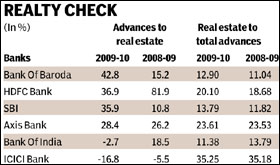While multinationals prefer per capita energy consumption-based IGBC, others say Griha more suited to India
Devesh Chandra Srivastava
Developers are split down the middle as two green rating agencies hardsell the advantages of their respective building certification methods.
Leed is the short form for Leadership in Energy and Environmental Design, whose standards are backed by the Confederation of Indian Industry and has been in use in India
Griha officials claim that their test is more suited to Indian realities.
“Griha is an easy, yet comprehensive rating system designed for India US New Delhi
“International codes usually take a hypothetical case. Griha takes an absolute number, which is easily understood,” said Mili Majumdar, associate director for sustainable building sciences at The Energy and Resources Institute, which built the Griha ratings in 2005 with funding from the ministry of new and renewable energy.
The ministry has made it mandatory for government buildings to obtain a Griha rating as a precondition for departments to get subsidies and other financial assistance for green development
Griha’s Kishan also believes its rating parameters are tougher: “We have found buildings to be not so green as per our parameters, but which have been certified by the IGBC.”
Currently, there are more than 50 projects being built across India
However, IGBC chairman, P.C. Jain said, “There is no conflict between the two rating systems. A Griha rated building is a platinum Leed building as per our standards.”
He added, “We constantly upgrade our rating parameters as per Indian conditions. In fact, Griha has no upgrade as it involves the slow-paced government machinery. But eventually, these two systems should become one.”
The two rating systems may also confuse developers over the certification of their projects and buildings.
Kishan of Griha said, “Developers often use IGBC’s certificate for an image makeover. Going ahead, (the ministry) would probably ask state governments to incorporate the best points of Griha and IGBC on a voluntary basis.”
Many developers tilt towards the Leed India ratings.
Said New Delhi-based developer Vidur Bharadwaj, director of 3C Company: “The objective of both the organizations is to encourage environment-friendly buildings. However, IGBC has higher exposure to the West. This makes it much more acceptable to multinationals. IGBC is also simple and easy to understand and follow.” 3C Company has designed several energy-efficient commercial buildings.
A spokesperson of Amby Valley City
But Griha has its supporters as well.
“We decided to go with Griha because it is more suited to Indian climate. Unlike Leeds , it does not promote usage of certain products like glass and air-conditioning equipment,” said Shashank Jain, chief operating officer of Ansal API, which has tied up with Griha for a project in Gurgaon.
Padmaparna Ghosh contributed to this story. Source: Live Mint




 ), one of the biggest names in the IT industry, which recruits the cr me-de-le-cr me of professionals from the best institutes in the country, spend $184 million on training programmes annually or invest up to 30 weeks of residential programmes on engineers it hires? The answer is simple the need to build employee competency levels. Says Srikantan Moorthy, VP and head, education & research, Infosys Technologies, "We recruit people on the basis of their learning ability. The investment is a non-negotiable. Besides training we conduct residential programmes to enable our engineers to meet client requirements. The need of the hour is not just for individuals to have strong conceptual knowledge, but also strong application capabilities." His information is, perhaps, an indicator of how inadequate India's education system is when it comes to preparing an individual for a job.
), one of the biggest names in the IT industry, which recruits the cr me-de-le-cr me of professionals from the best institutes in the country, spend $184 million on training programmes annually or invest up to 30 weeks of residential programmes on engineers it hires? The answer is simple the need to build employee competency levels. Says Srikantan Moorthy, VP and head, education & research, Infosys Technologies, "We recruit people on the basis of their learning ability. The investment is a non-negotiable. Besides training we conduct residential programmes to enable our engineers to meet client requirements. The need of the hour is not just for individuals to have strong conceptual knowledge, but also strong application capabilities." His information is, perhaps, an indicator of how inadequate India's education system is when it comes to preparing an individual for a job.







